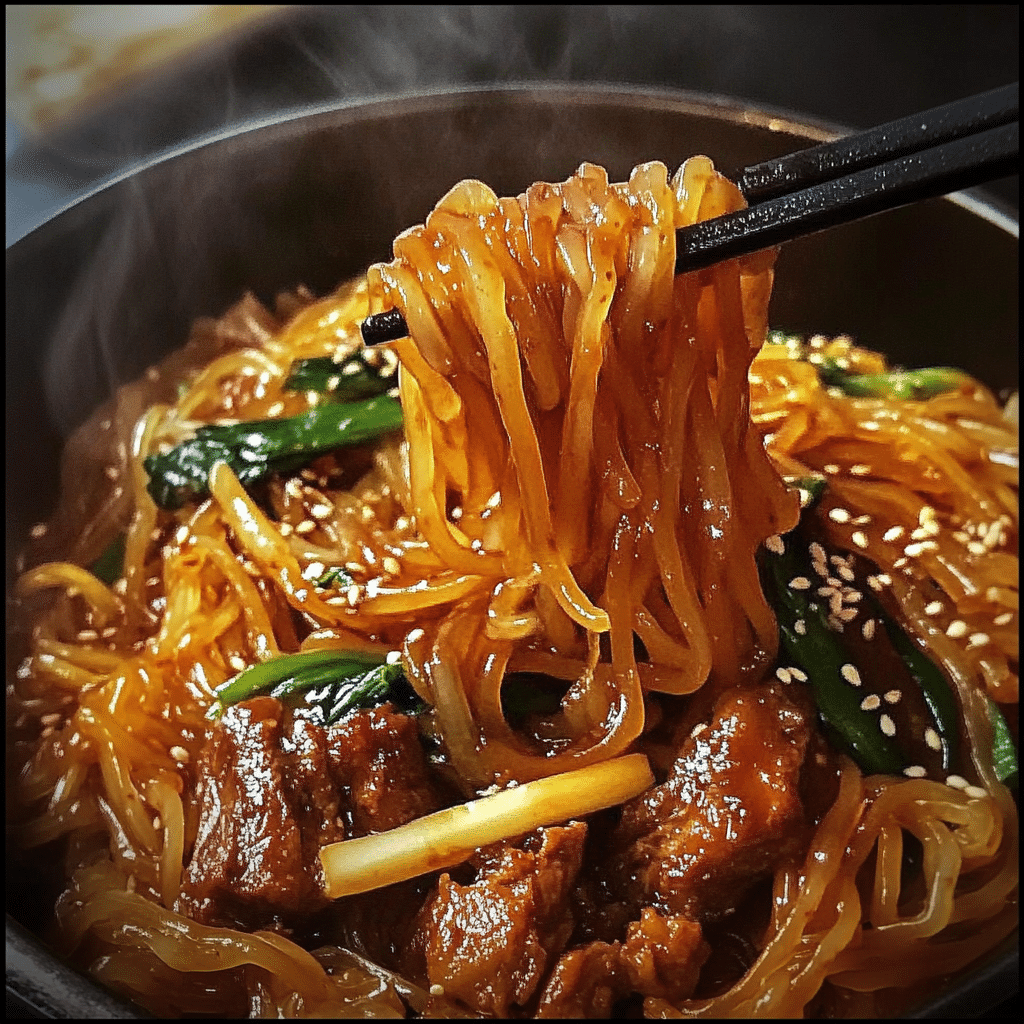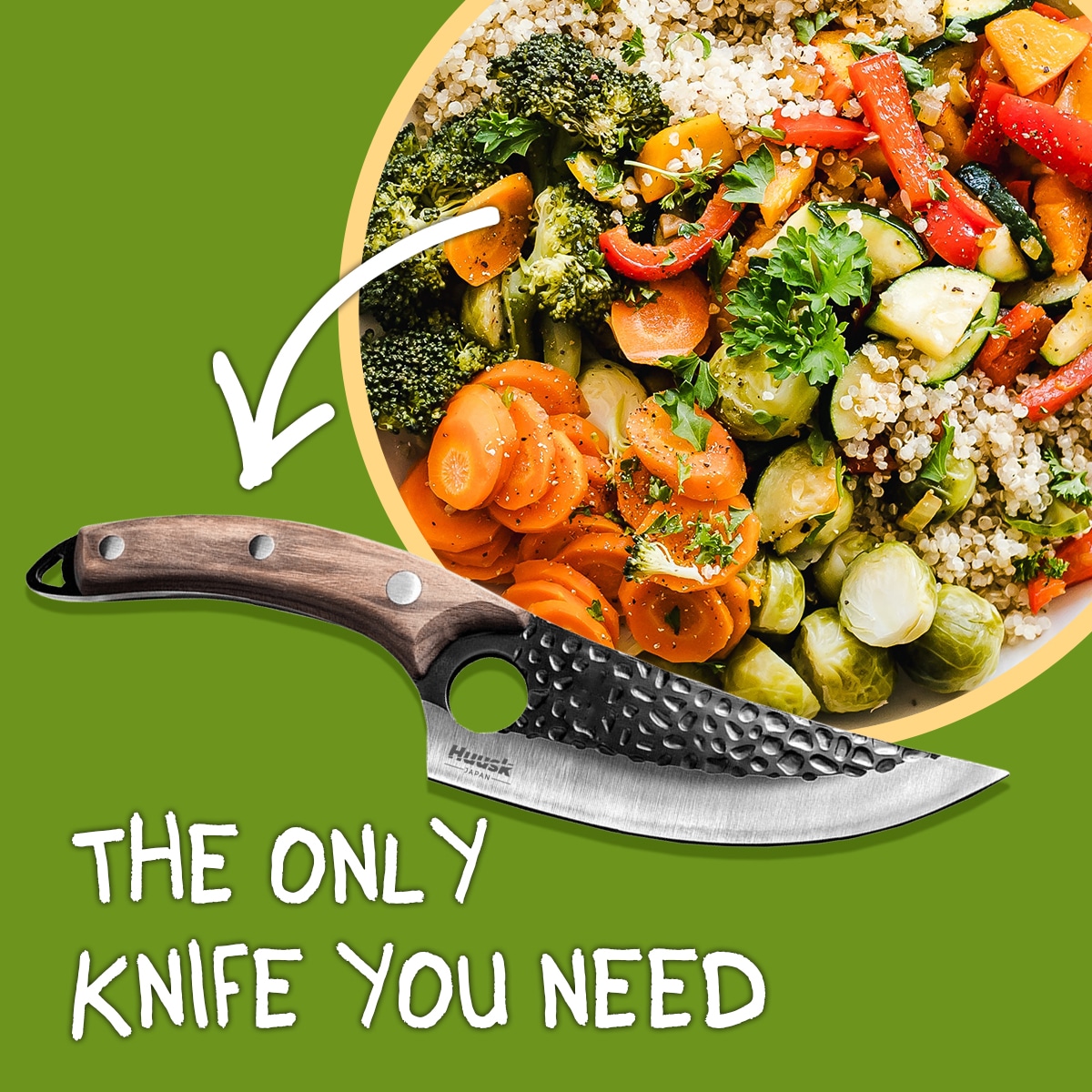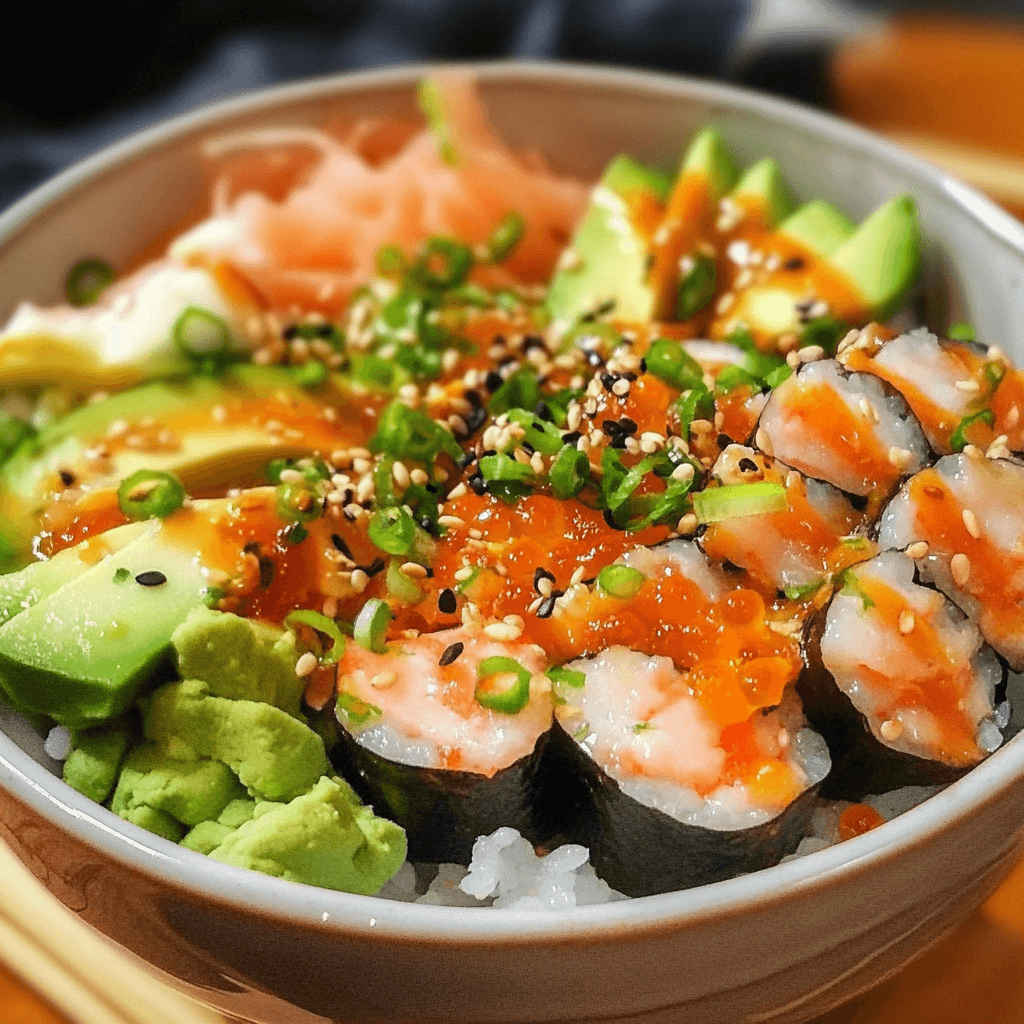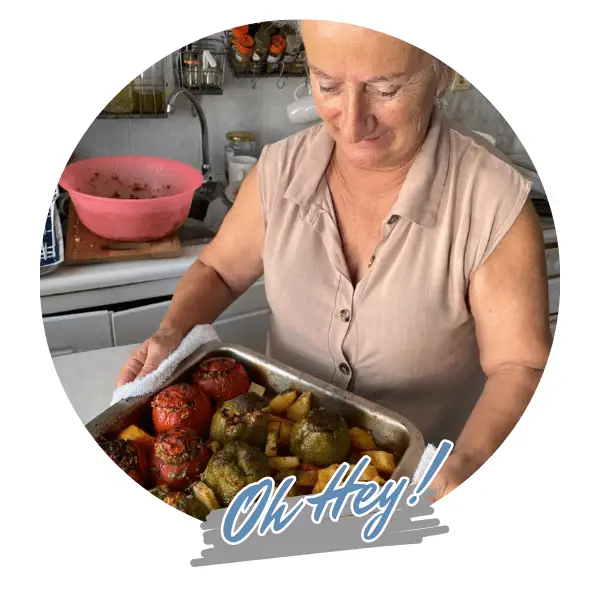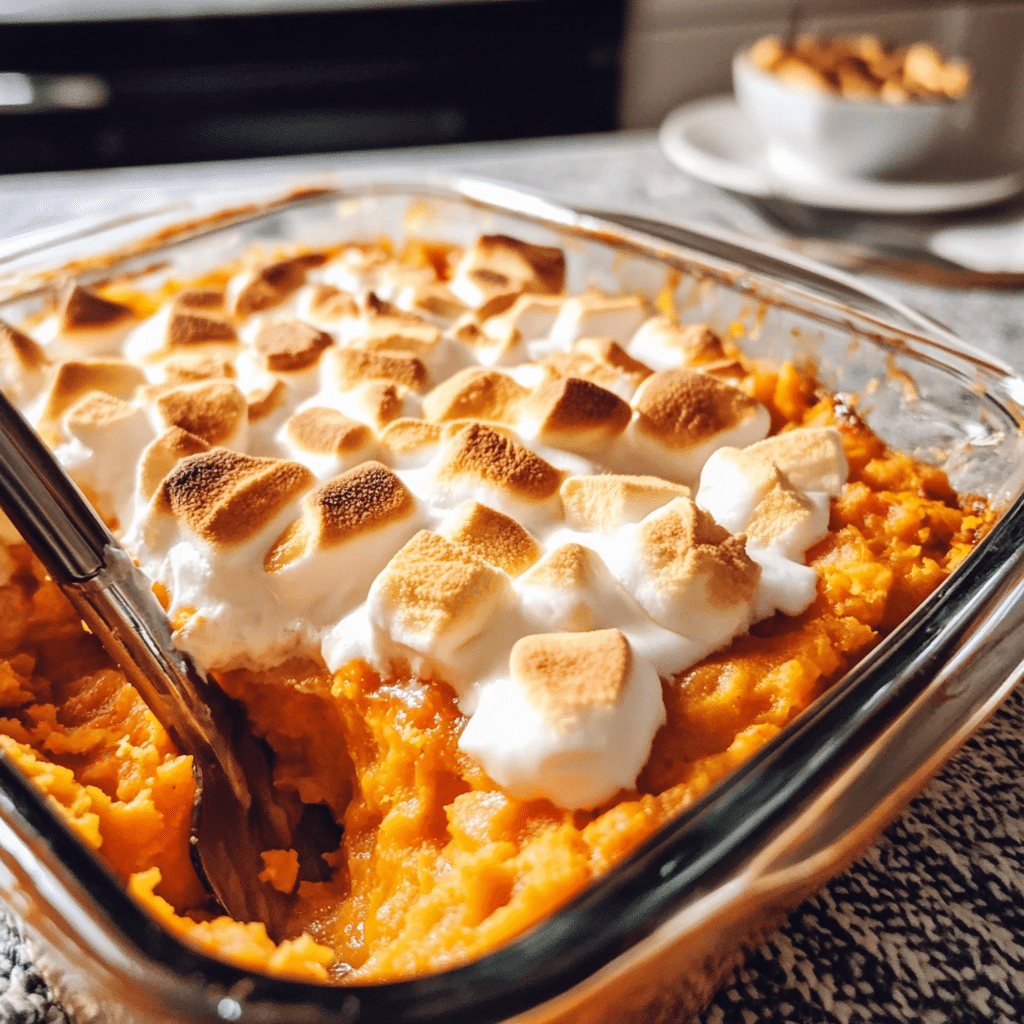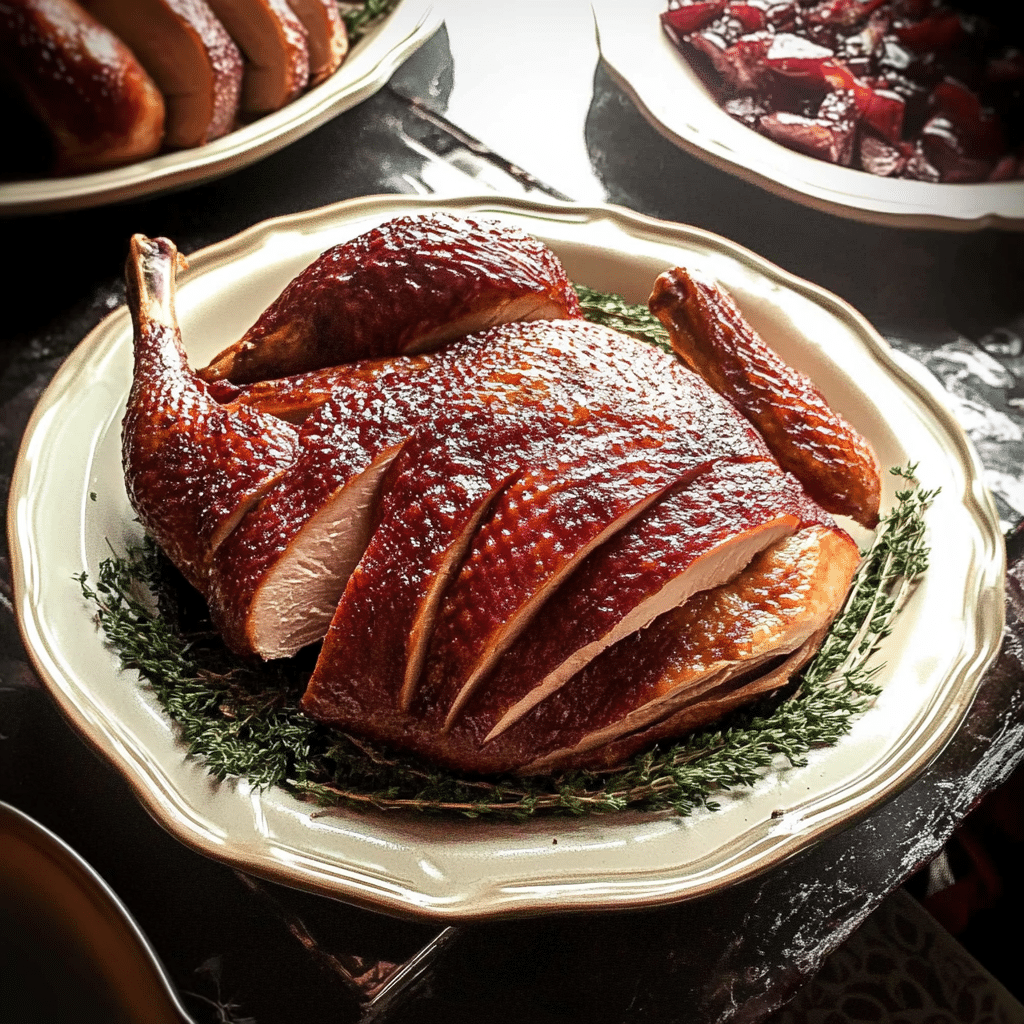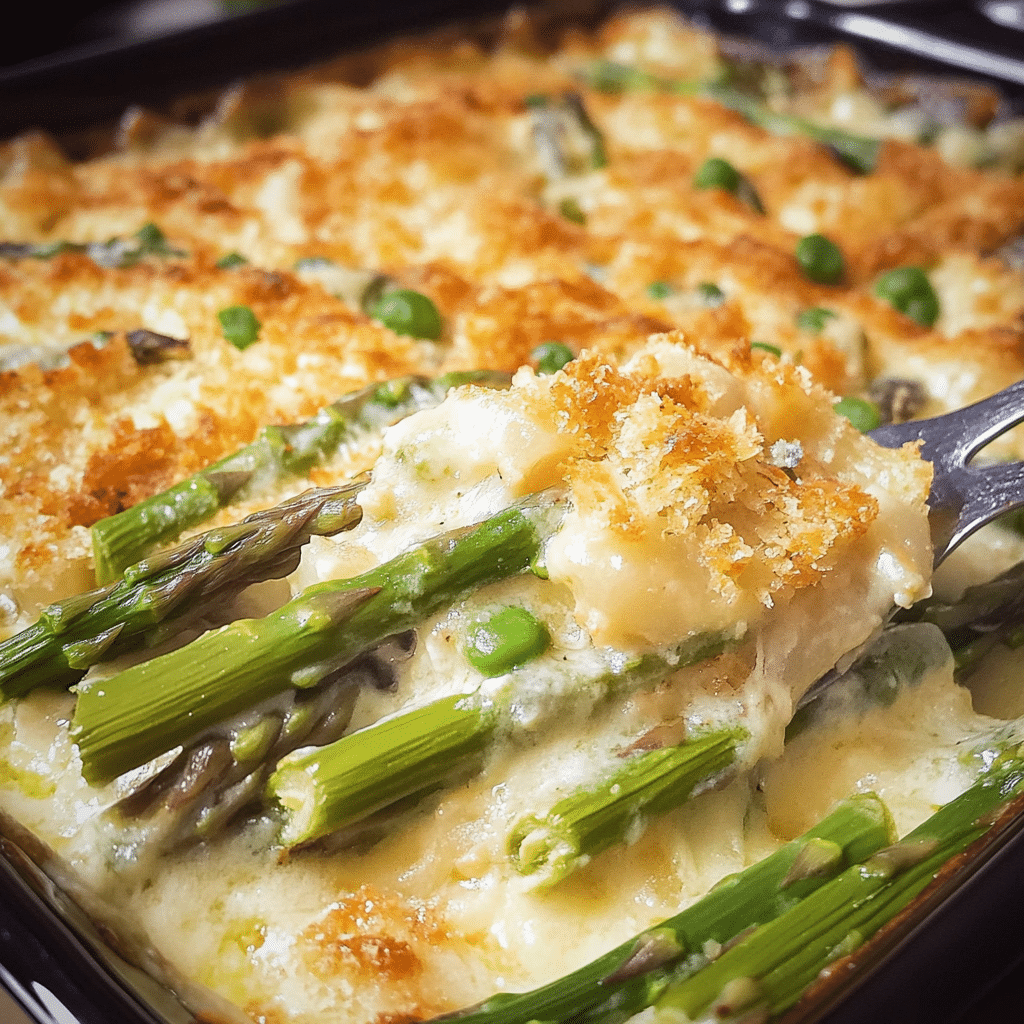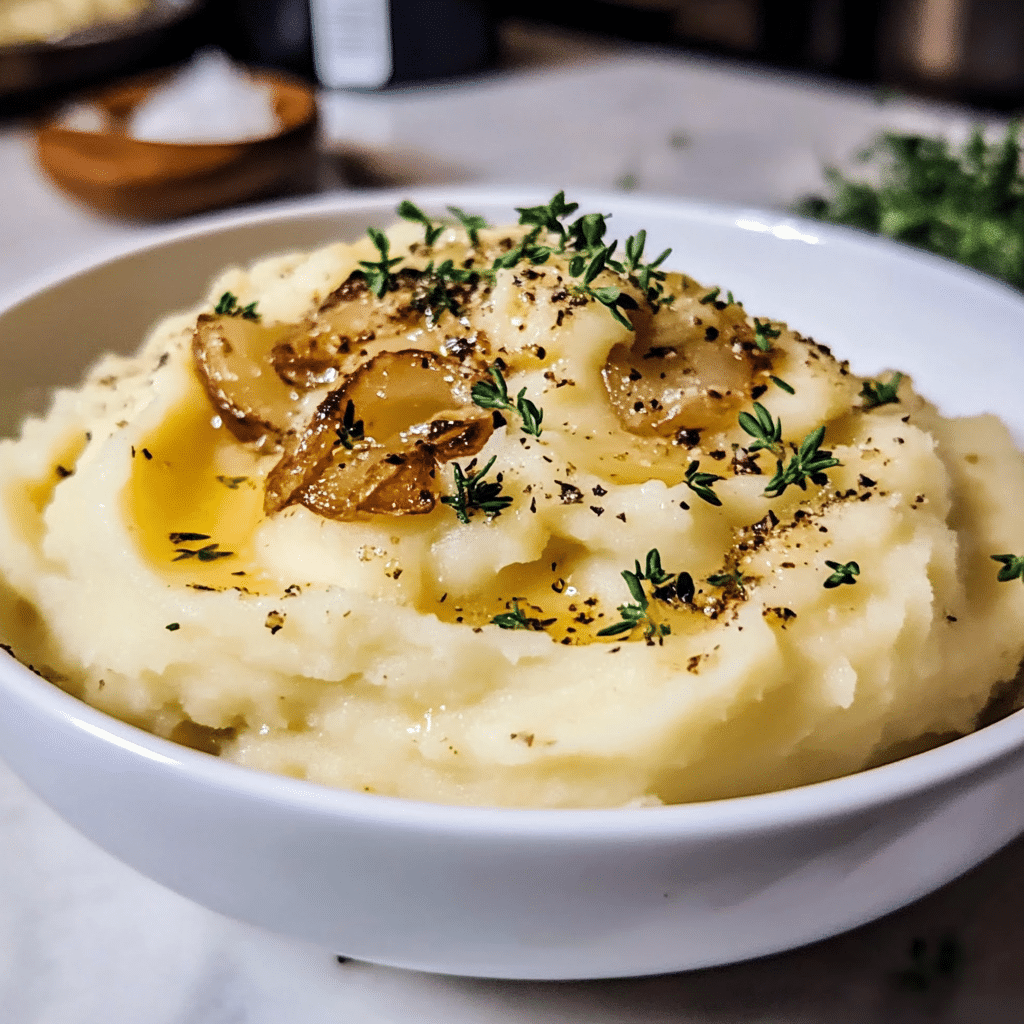Introduction
If you’ve ever craved a dish that’s both deliciously savory and delightfully colorful, look no further than Authentic Korean Japchae Noodles! This beloved Korean dish is a vibrant, stir-fried noodle dish that combines perfectly seasoned sweet potato starch noodles with a rainbow of vegetables, savory beef (or your choice of protein), and a sweet-savory soy sauce. The texture of the noodles is wonderfully chewy, and the medley of ingredients creates an explosion of flavor in every bite. Japchae is a dish that holds special meaning in Korean cuisine, often prepared for celebrations or gatherings, yet it’s simple enough to be made for a weeknight dinner.
In this recipe, we’ll break down the steps to recreate this authentic Korean favorite in your own kitchen, offering tips, variations, and even a personal story to make it come alive. Whether you’re new to Korean cuisine or an experienced cook, this dish is bound to become a staple in your cooking repertoire. Ready to try making your own Japchae at home? Let’s dive in!
Why You’ll Love This Recipe
Here’s why you’ll be hooked on Authentic Korean Japchae Noodles:
- A Flavorful Feast: The combination of sweet, savory, and umami flavors will leave you coming back for more.
- Colorful and Vibrant: With its beautiful mix of vegetables and glossy noodles, Japchae looks as good as it tastes.
- Customizable: Swap out vegetables or proteins to make it your own! Chicken, pork, tofu, or even seafood are excellent choices.
- Simple Ingredients: Made with easy-to-find ingredients like soy sauce, sesame oil, and stir-fry vegetables.
- A Healthy Dish: Packed with nutrient-rich veggies, protein, and fiber, it’s a balanced meal that doesn’t skimp on flavor.
- A Taste of Korea: Japchae is a beloved dish in Korean culture, often served at festive events and gatherings, so making it brings a little piece of Korean tradition into your home.
- Satisfying: With the chewy texture of the sweet potato noodles, Japchae is filling but not too heavy, making it perfect for lunch or dinner.
- Great for Leftovers: Japchae stores well, and the flavors deepen after sitting in the fridge for a day or two, making it a great meal prep option.
Preparation Time and Cook Time
- Total Time: 45 minutes
- Preparation Time: 15 minutes
- Cook Time: 30 minutes
- Servings: 4-6 servings
- Calories per serving: Approximately 350 calories
- Key Nutrients: Protein: 20g, Fat: 14g, Carbohydrates: 50g, Fiber: 5g
Ingredients
Before you begin, gather the following ingredients to create your Authentic Korean Japchae Noodles:
the Noodles:
- 8 oz (225g) sweet potato starch noodles (dangmyeon)
For the Stir-Fried Vegetables:
- 1 tablespoon sesame oil (divided)
- 1 small onion, thinly sliced
- 1 small carrot, julienned
- 1 cup spinach (blanched)
- 1/2 red bell pepper, julienned
- 1/2 yellow bell pepper, julienned
- 1/2 cup shiitake mushrooms (or button mushrooms), thinly sliced
the Protein (optional):
- 1/2 lb (225g) beef (sirloin or ribeye), thinly sliced into strips (alternatively, you can use chicken, pork, or tofu)
For the Seasoning:
- 2 tablespoons soy sauce
- 1 tablespoon sugar
- 1 tablespoon sesame oil
- 2 teaspoons minced garlic
- 1 tablespoon rice vinegar
- 1 tablespoon mirin (optional)
- 1 tablespoon toasted sesame seeds
- Ground black pepper, to taste
Ingredient Highlights
- Sweet Potato Noodles: These are the star of Japchae, offering a chewy, satisfying texture that’s crucial to the dish’s authenticity.
- Vegetables: A colorful mix of carrots, bell peppers, spinach, and mushrooms not only adds vibrant colors but also gives the dish a fresh, healthy element.
- Sesame Oil: This rich oil imparts a nutty, deep flavor that ties the entire dish together.
- Soy Sauce: The foundation of the savory, umami taste that makes Japchae so irresistible.
- Mirin and Rice Vinegar: These ingredients add balance to the dish, cutting through the richness with a touch of sweetness and acidity.
Step-by-Step Instructions
Follow these steps to create your Authentic Korean Japchae Noodles:
Prepare the Noodles
- Cook the Noodles: Begin by boiling a pot of water. Add the sweet potato noodles (dangmyeon) to the pot and cook according to the package instructions, usually about 7-10 minutes. These noodles should be chewy but not too soft. Drain them, rinse with cold water to stop the cooking process, and set aside. You can drizzle a little sesame oil over them to keep them from sticking.
- Season the Noodles: Once the noodles are cooked and drained, drizzle them with 1 tablespoon of sesame oil to keep them separated and add flavor. Set aside.
Prepare the Vegetables and Protein
- Stir-Fry the Vegetables: In a large skillet or wok, heat 1 tablespoon of sesame oil over medium-high heat. Add the onion, carrots, bell peppers, and mushrooms. Stir-fry for 3-5 minutes until the vegetables soften but remain crisp. You want them to retain their color and texture. Add the spinach at the very end, allowing it to wilt quickly. Remove the vegetables from the skillet and set them aside.
- Cook the Protein: If you’re using beef (or your chosen protein), add a little more sesame oil to the skillet. Stir-fry the beef strips for 2-3 minutes until just cooked through. You can also add garlic at this stage for extra flavor. Once the beef is cooked, remove it from the skillet and set it aside.
Assemble the Japchae
- Combine Everything: In the same skillet, add the cooked noodles, stir-fried vegetables, and cooked beef (or your protein). Toss everything together gently to mix.
- Add Seasoning: In a small bowl, mix together the soy sauce, sugar, sesame oil, minced garlic, rice vinegar, and mirin (if using). Pour this sauce over the noodles and toss everything to coat evenly. Continue to stir-fry for another 2-3 minutes, allowing the flavors to meld and the noodles to soak up the sauce.
- Finishing Touches: Once the dish is well combined and heated through, sprinkle toasted sesame seeds on top and season with ground black pepper to taste.
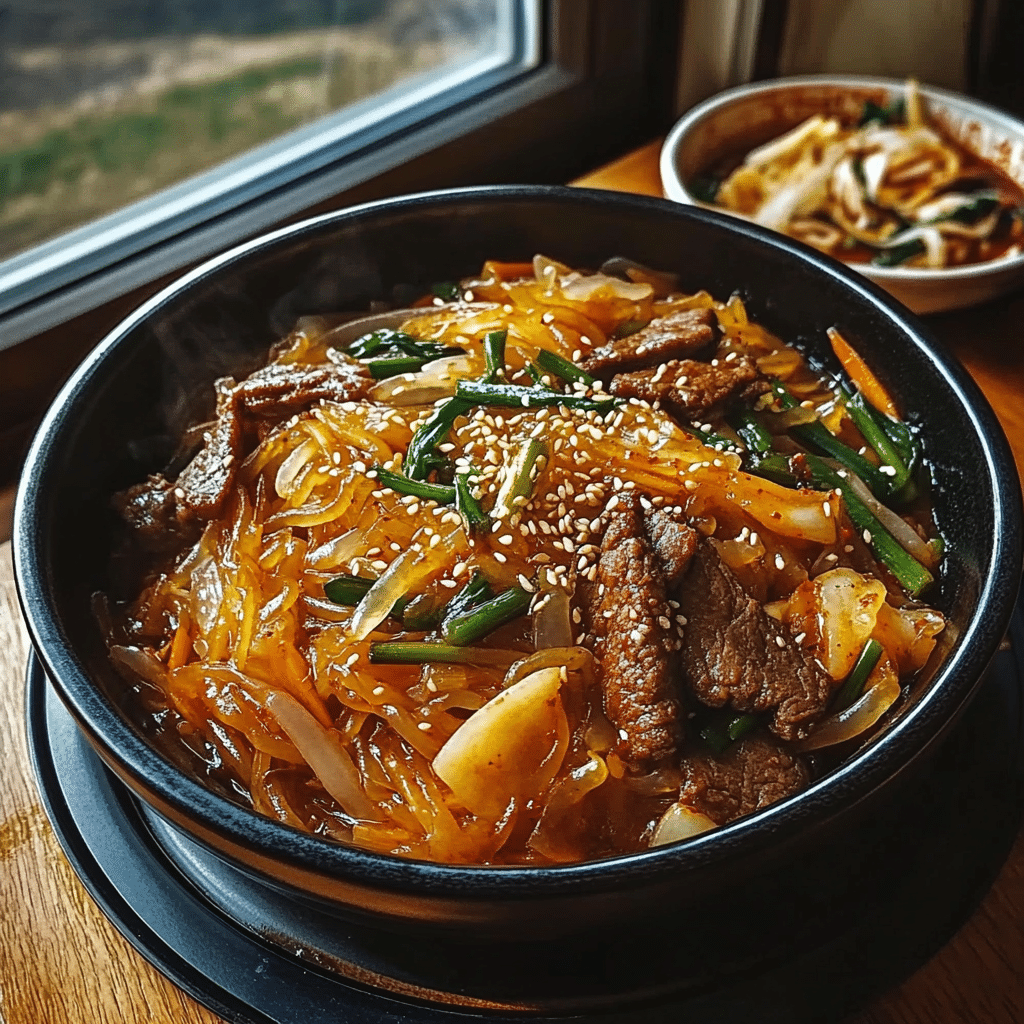
How to Serve
Here are some fun serving ideas for your Authentic Korean Japchae Noodles:
- Serve Family-Style: Plate the Japchae in a large serving bowl and let everyone dig in. It’s perfect for family-style meals or potlucks.
- Pair with Banchan: In Korean cuisine, Japchae is often served alongside a variety of small side dishes known as banchan. Serve it with kimchi, pickled vegetables, or other Korean sides to create a full meal.
- Garnish with Fresh Herbs: Garnish the dish with fresh cilantro or green onions for an added burst of flavor.
- Add a Fried Egg: For extra richness, top your Japchae with a fried egg, sunny-side up or scrambled.
Additional Tips
Maximize your enjoyment of Authentic Korean Japchae Noodles with these helpful tips:
- Make Ahead: Japchae can be made ahead of time and stored in the fridge for up to 3 days. The flavors actually improve as they sit, making it perfect for meal prep.
- Customize the Vegetables: You can use any vegetables you have on hand, such as zucchini, broccoli, or asparagus, to make the dish your own.
- Adjust the Sweetness: If you prefer your Japchae on the sweeter side, add a little more sugar or mirin to the sauce.
- Don’t Overcook the Noodles: Sweet potato noodles are best when they’re slightly chewy, so don’t overcook them!
- Serving Size: Japchae is quite filling, so a little goes a long way. Serve it with a side of rice or kimchi for a complete meal.
Recipe Variations
Consider these creative variations for your Authentic Korean Japchae Noodles:
- Vegan Japchae: Skip the meat and use tofu or tempeh as your protein source. The dish will still be full of flavor and satisfying.
- Spicy Japchae: Add a spoonful of gochujang (Korean chili paste) or some sliced fresh chili peppers for a spicy kick.
- Japchae with Shrimp: Shrimp adds a delicious seafood flavor that pairs beautifully with the vegetables and noodles.
- Japchae with Mushrooms: Use an assortment of wild mushrooms, such as shiitake, enoki, or oyster, for a more umami-packed version of Japchae.
- Japchae Soup: Add a little more broth and serve Japchae as a warm, comforting soup.
Frequently Asked Questions (FAQ)
Before you dive into making your own Authentic Korean Japchae Noodles, you might have a few questions. Don’t worry, I’ve got you covered! Here are some of the most common questions I get, along with helpful tips to ensure your Japchae turns out perfectly every time:
Can I use regular pasta instead of sweet potato noodles?
While you can technically use regular pasta, sweet potato noodles (dangmyeon) give Japchae its signature chewy texture. I highly recommend using them for the best authentic taste and texture.
Can I make this dish vegetarian or vegan?
Absolutely! Simply replace the beef with tofu or tempeh for a plant-based version. You can also skip the mirin if you want to make it completely vegan.
How do I store leftovers?
Leftovers can be stored in an airtight container in the fridge for up to 3 days. The flavors often improve as it sits, making it perfect for meal prepping.
Can I freeze Japchae?
While it’s best enjoyed fresh, you can freeze Japchae for up to 1 month. Make sure to store it in a freezer-safe container. When ready to eat, just reheat it in a pan or microwave.
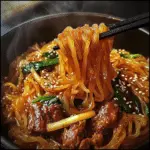
Authentic Korean Japchae Noodles
- Total Time: 45 min.
Ingredients
For the Noodles:
- 8 oz (225g) sweet potato starch noodles (dangmyeon)
For the Stir-Fried Vegetables:
- 1 tablespoon sesame oil (divided)
- 1 small onion, thinly sliced
- 1 small carrot, julienned
- 1 cup spinach (blanched)
- 1/2 red bell pepper, julienned
- 1/2 yellow bell pepper, julienned
- 1/2 cup shiitake mushrooms (or button mushrooms), thinly sliced
For the Protein (optional):
- 1/2 lb (225g) beef (sirloin or ribeye), thinly sliced into strips (alternatively, you can use chicken, pork, or tofu)
For the Seasoning:
- 2 tablespoons soy sauce
- 1 tablespoon sugar
- 1 tablespoon sesame oil
- 2 teaspoons minced garlic
- 1 tablespoon rice vinegar
- 1 tablespoon mirin (optional)
- 1 tablespoon toasted sesame seeds
- Ground black pepper, to taste
Instructions
Prepare the Noodles
- Cook the Noodles: Begin by boiling a pot of water. Add the sweet potato noodles (dangmyeon) to the pot and cook according to the package instructions, usually about 7-10 minutes. These noodles should be chewy but not too soft. Drain them, rinse with cold water to stop the cooking process, and set aside. You can drizzle a little sesame oil over them to keep them from sticking.
- Season the Noodles: Once the noodles are cooked and drained, drizzle them with 1 tablespoon of sesame oil to keep them separated and add flavor. Set aside.
Prepare the Vegetables and Protein
- Stir-Fry the Vegetables: In a large skillet or wok, heat 1 tablespoon of sesame oil over medium-high heat. Add the onion, carrots, bell peppers, and mushrooms. Stir-fry for 3-5 minutes until the vegetables soften but remain crisp. You want them to retain their color and texture. Add the spinach at the very end, allowing it to wilt quickly. Remove the vegetables from the skillet and set them aside.
- Cook the Protein: If you’re using beef (or your chosen protein), add a little more sesame oil to the skillet. Stir-fry the beef strips for 2-3 minutes until just cooked through. You can also add garlic at this stage for extra flavor. Once the beef is cooked, remove it from the skillet and set it aside.
Assemble the Japchae
- Combine Everything: In the same skillet, add the cooked noodles, stir-fried vegetables, and cooked beef (or your protein). Toss everything together gently to mix.
- Add Seasoning: In a small bowl, mix together the soy sauce, sugar, sesame oil, minced garlic, rice vinegar, and mirin (if using). Pour this sauce over the noodles and toss everything to coat evenly. Continue to stir-fry for another 2-3 minutes, allowing the flavors to meld and the noodles to soak up the sauce.
- Finishing Touches: Once the dish is well combined and heated through, sprinkle toasted sesame seeds on top and season with ground black pepper to taste.
- Prep Time: 15 min.
- Cook Time: 30 min.
Nutrition
- Serving Size: 4-6 servings
- Calories: 350 kcal
- Fat: 14g
- Carbohydrates: 50g
- Fiber: 5g
- Protein: 20g
Conclusion
Authentic Korean Japchae Noodles are the perfect combination of savory, sweet, and satisfying. With their chewy texture and delightful mix of veggies and protein, they’re sure to become a favorite in your household. This dish is perfect for any occasion—whether you’re hosting a dinner party, meal prepping for the week, or simply craving something flavorful and fun to make. Plus, with all the different variations and creative possibilities, you can easily customize this recipe to suit your tastes.
Don’t forget to snap a photo and tag me on social media—I love seeing your delicious creations!

